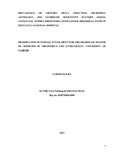| dc.description.abstract | Lower abdominal pain is one of the commonest complaints among antenatal women. In
the absence of accessible laboratory services bacterial infection is a presumptive diagnosis. This is justified by the feto-maternal complications of untreated urinary tract infection in pregnancy. Therefore antibiotics are frequently prescribed empirically. In absence of bed side dipsticks and microbiology services, this results in excessive prescription of antibiotics with precedent complications including but not limited to resistant microbial agents in the population.
Lower abdominal pain has multiple a etiology, not limited to urinary tract infections, and routine prescription of antibiotics increases the population risk of antibiotic resistance.
In presence of infection there is need for institution guidelines on sensitivity patterns to advise on prescription and increase cure rates.
Research Objectives: To determine the prevalence of bacterial urinary tract infection as a cause of lower abdominal pains, microbial etiology and antibiotic sensitivity, among women attending antenatal clinics and labor ward in Kenyatta National Hospital.
Study design: A cross sectional study among antenatal women at Kenyatta National
Hospital.
Methods: One hundred and fifty women who were not in labour but complaining of lower abdominal pain were enrolled. They were recruited from antenatal clinics and wards at the hospital and enrolled by consecutive sampling until the desired sample size was attained. Social and obstetric history was obtained and a clean catch mid stream urine sample was collected from each of the women for dipstick testing, microscopy culture and sensitivity. The urine was cultured on cysteine lactose electrolyte deficient (CLED) and blood agar media. Any organism isolated with colony counts of greater than
100000/ml of urine was considered significant and indicative of a UTI. Bacterial identification was done using the methods of Cowen and Steele. Antibiotic sensitivity patterns were studied using the disc diffusion method.
RESULTS:
Among antenatal women presenting with lower abdominal pains in Kenyatta National Hospital, 26.7% were confirmed with bacterial urinary tract infection. E.coli was isolated in 40%, Staphylococcal species in 25%, klebshiella species in 10% and proteus
species in 10% of urine samples. Other isolates were enterococus, enterobacter and citrobacter specie. There was 100% sensitive to meropenem, imepenem, augmentin, ceftazidime and levofloxacin and about 81% to cefuroxime among isolated gram negative bacteria. Resistance to gentamycin and ampicilin was 80%. Gram positive bacteria were
100% sensitive to augmentin, cefuroxime, ceftriaxone, ceftazidime, meropenem and imepenem, with 20-80% resistance to levofloxacin, gentamycin, nitrofurantoin and ampicilin.
The dipstick screening test is 77.5% sensitive and 83.6% specific in diagnosis of bacterial urinary tract infection with positive predictive value of 63.3% and negative predictive value of 91.1%. Urine microscopy test showed a sensitivity of 67.5% and specificity of
88.2%, with positive predictive value of 67.5% and negative predictive value of 88.2%.
Conclusions
Less than one third of pregnant women presenting with lower abdominal pains actually had bacterial urinary tract infection. The microbial profile included E.coli at 40%, staph spp at 25% and other gram negative species
There clear sensitivity patterns and some resistance was noted
Recommendations
Empirical treatment of women with lower abdominal pain in pregnancy with antibiotics results in overtreatment and is not justified. We recommend routine screening of all antenatal mothers with lower abdominal pain with urine dipstick tests to determine presence of UTI before initiation of antibiotics. Augmentin is universally highly effective against all the microbes and is recommended for empirical use where laboratory facilities are not available. Routine feedback of antibiotic sensitivity patterns to advise clinicians on prescription is recommended. | en |
| dc.description.department | a
Department of Psychiatry, University of Nairobi, ; bDepartment of Mental Health, School of Medicine,
Moi University, Eldoret, Kenya | |

